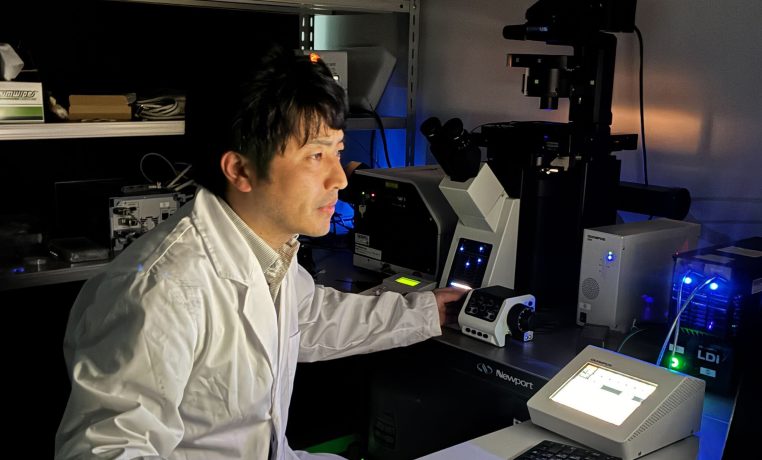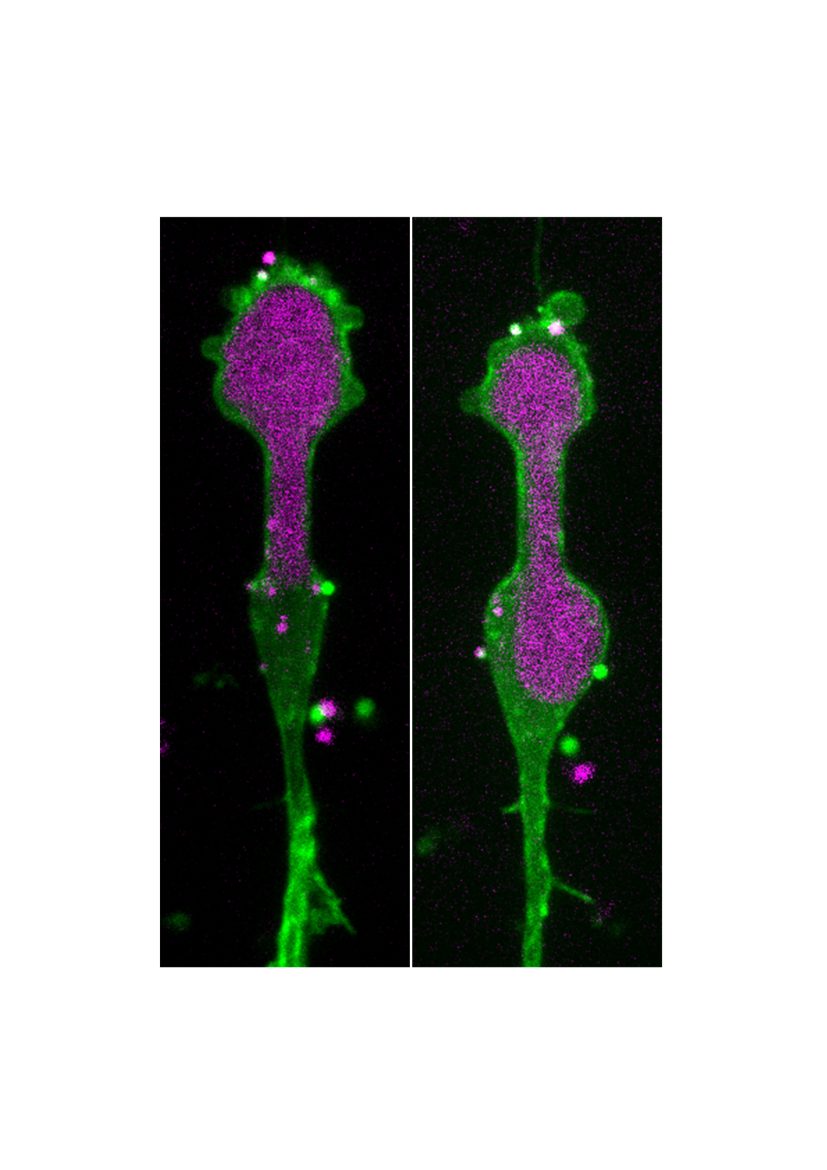Squeezing Through: Nuclear Migration Strategies in the Developing Brain
Lecturer at Department of Energy and Materials, Faculty of Science and Engineering, Kindai University
Program-Specific Assistant Professor (Kengaku Lab), at the time of this research.
Naotaka Nakazawa
Naotaka Nakazawa
Dr Nakazawa, currently affiliated with Kindai University, works on mechanisms of mechano-sensing and response in neurons and cancer cells. His latest research reveals that migrating neurons switch between different modes of movement depending on the three-dimensional size of the space surrounding them during brain development.

Please share with us the significance of your manuscript in terms of its research achievements, impact, or uniqueness.

The key finding of this work is that migrating neurons switch between different modes of movement depending on whether they are in two-dimentional or three dementional microenvironments during brain development. At the molecular level, the mechano sensitive ion channel PIEZO1 detects mechanical stress as neurons pass through confined 3D spaces and helps generate the appropriate driving force for movement. In previous studies, distinctactomyosin-driven mechanisms for nuclear translocation—either front-driven or rear driven—have been observed across different neuron types and experimental conditions. However, the reason behind differences remained unclear. Our results suggest that neurons adapt their motility mode in response to the spatial confinement of the extracellular microenvironment.
Please tell us what was the most gratifying or inspiring moment for you during this research project.
The most gratifying moment was when we observed neurons in microdevice channels passing through a confined space in a way we had never seen before. The cerebellar granule cells are known to move their nuclei by pulling force at the nuclear front, maintaining the elongated shape of the neurite in front and behind. But in this case, the processes behind the nucleus suddenly became much shorter. Excited and anxious to see what would happen next, I continued to watch. As the tip of the nucleus entered the narrow space, I noticed that the cell membrane at the back of the nucleus took on the blebbing structure. Since membrane blebbing is also a sign of cell death, I wondered if the cell might die, but as I continued to watch. The nucleus passed through the narrow space as if being pushed with the membrane blabbing allowing the neuron to continue moving along the path. At that moment, I thought, "We did it!” Before this experiment, our hypothesis was that the nucleus moves through a narrow space by contracting the membrane behind it. Since a blebbing shape is a sign of membrane contraction, this result seemed to support our hypothesis. Subsequently, similar dynamics were observed in other samples, providing the key experimental results for this study.
Please tell us about the biggest challenge or problem you experienced while conducting your research. How did you overcome it?
The most challenging aspect was how to reproduce the confined space inside the brain. To overcome this, we invited Dr Gianluca Grenci from the Mechanobiology Institute at the National University of Singapore, where I used to work, to the iCeMS Retreat. This invitation served as a springboard for us to begin our collaboration to develop an original microfluidic device system. On the recommendation of Prof Kengaku, I also visited Singapore multipuletimes (although travel was temporarily suspended due to the COVID-19 pandemic) to test the conditions by having them fabricate the channels and perform culture experiments. As a result, the final experimental conditions were determined and we were able to obtain the data described in our study. In addition, although I had no prior experience handling transgenic mice, I received considerable support from Dr Junko Kurisu from the Kengaku group and I was able to successfully conduct experiments using conditional knockout (cKO) mice. I firmly believe that the many challenges I faced in advancing this research could not have been overcome without the collaboration of fellow researchers, and I am deeply grateful for their support.
Would you consider this work to be a turning point in your overall research direction? If so, how has your research direction changed as a result of this work?
Absolutely. In this study, I incorporated many techniques from my earlier work in mechanobiology into the neuroscience research that I pursued in the Kengaku group. Mechanobiology techniques were already being used at the Kengaku lab before I joined, but I feel that our collaboration with other researchers allowed us to further deepen our neuroscience research using these approaches. The National University of Singapore, where I worked before joining iCeMS, is one of the leadinc centers for the field of mechanobiology, but still, few researchers had applied the approaches to neuroscience. By conducting neuroscience research using mechanobiology techniques at iCeMS, I have not only broadened my own perspective and experimental approaches, but I also believe that I have brought fresh insights to both the fields. My experience at iCeMS was truly a major turning point in shaping the direction of my curent and future research.
Please describe the current situation of your career. What is your current position? How has the knowledge and experience gained at iCeMS influencing your career?
I am currently a lecturer at Kindai University, where I am affiliated with the Faculty of Science and Engineering, Department of Energy and Materials, which was established in 2022. I am responsible for both research and education in my own laboratory, as well as for delivering lectures on basic and specialized topics in the department's undergraduate curriculum. The environment at iCeMS, where researchers from diverse research fields actively interact, encouraged me to develop a playful curiosity about the appeal of research in other fields, as well as a strong interest in finding connections between interdisciplinary research ideas and my own work. I believe that my experience at iCeMS has led to the opportunityto engage in research and teaching at my current institution. My current department also offers an interdisciplinary environment, with faculty members from physics, chemistry, and biology, which reminds me of the atmosphere at iCeMS. I feel strongly that the playfulness and curiosity I cultivated at iCeMS continue to play a valuable role in both my research and teaching.
Finally, please give a message or advice to young iCeMS researchers.
I hope you trulyl enjoy your scientific journey at iCeMS. First and foremost, it is important to pursue your own research in the excellent research environment that iCeMS provides. At the same time, if possible, I encourage you to interact with many researchers across lab boundaries and to have scientific discussions with others. By doing so, you will not only increase the potential for your research ideas and career opportunities to grow, but also have a positive influence those around you, helping to create a happier and more vibrant environment for everyone at iCeMS.
Paper information
“PIEZO1-dependent mode switch of neuronal migration in heterogeneous microenvironments in the developing brain”
Authors: Naotaka Nakazawa, Gianluca Grenci, Yoshitaka Kameo, Noriko Takeda, Tsuyoshi Sawada, Junko Kurisu, Zhejing Zhang, Kenichi Toma, Taiji Adachi, Keiko Nonomura, Mineko Kengaku
Published: March 2025